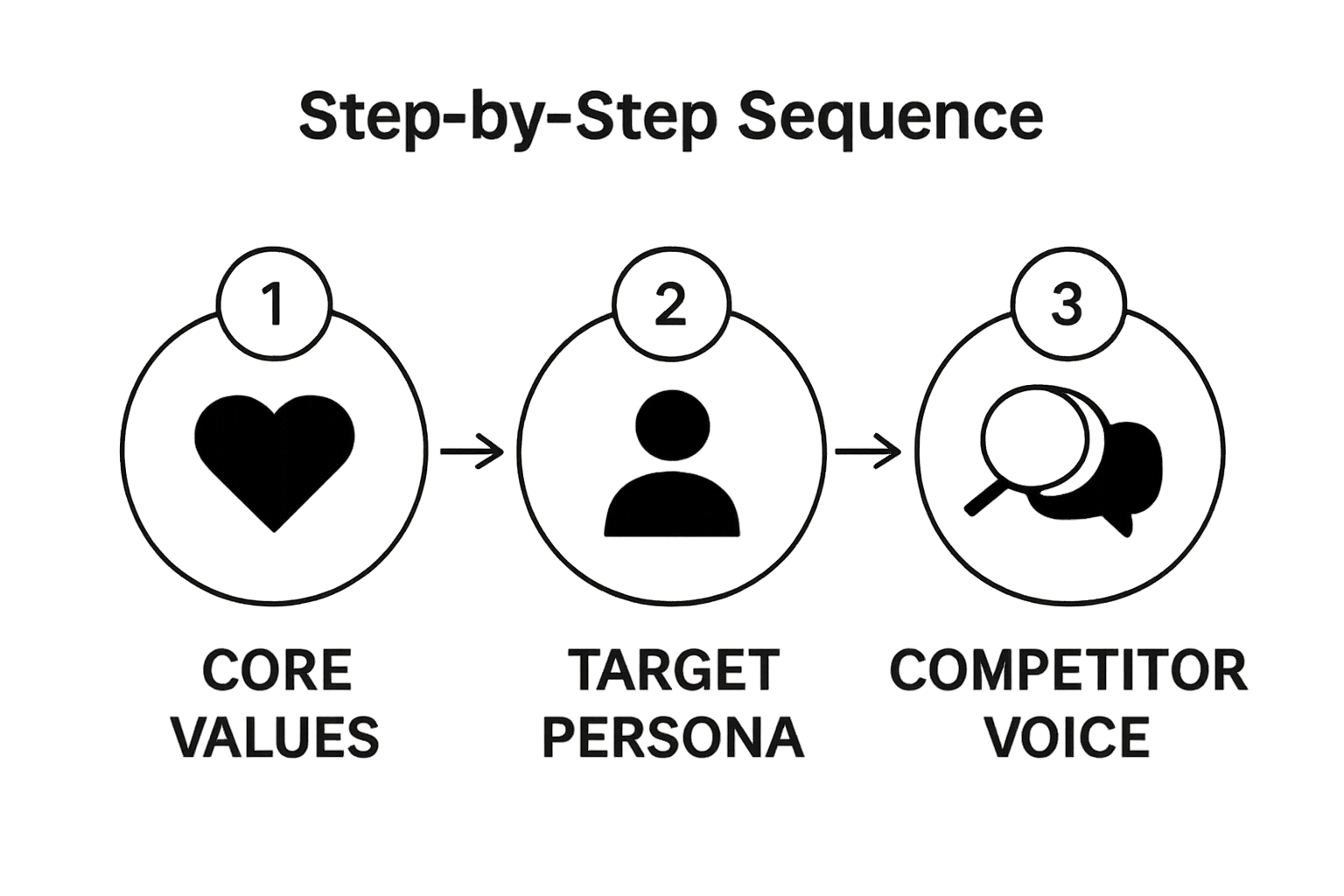How to Increase Brand Visibility with a Proven System

Learn how to create a brand voice step-by-step, ensuring clarity and consistency while connecting with your target audience effectively.

Strong brands are built on more than just logos and colors. Companies with well-defined core values outperform competitors by up to 15 percent in brand recognition and loyalty. Surprising, right? Most people think crafting a unique brand voice is all about clever slogans, but the truth is it starts with digging deep into what makes your business tick and who you really want to reach.
| Key Point | Explanation |
|---|---|
| 1. Define core values clearly | Core values should reflect authentic beliefs that guide all aspects of your brand. Focus on what truly matters to you beyond profit. |
| 2. Create a detailed audience persona | Understand the emotional, psychological, and professional characteristics of your ideal customer for tailored messaging. |
| 3. Analyze competitor voices strategically | Identify the strengths and weaknesses in competitors’ messaging to differentiate your brand voice and find unique opportunities. |
| 4. Develop a brand voice framework | Capture your brand’s personality with guidelines on communication that resonate with your core values and audience. |
| 5. Continuously test and refine voice | Regularly measure audience engagement and feedback to adapt your brand voice, ensuring it remains authentic and relevant. |
Building a powerful brand voice starts with understanding the fundamental principles that drive your business forward. Core values are the heartbeat of your brand, representing the authentic beliefs and principles that guide every decision, interaction, and communication strategy. Think of them as the invisible compass that steers your brand’s narrative and connects deeply with your audience.
Defining your core values requires honest introspection and strategic thinking. Begin by reflecting on why you started your business and what truly matters to you beyond financial success. Ask yourself profound questions: What problems are you passionate about solving? What unique perspective do you bring to your industry? What principles would you never compromise on, even if it meant losing a potential opportunity?
To uncover these foundational principles, schedule dedicated time for self-reflection. Grab a notebook or open a blank document and start brainstorming. Write down moments in your professional journey that made you feel most alive, most fulfilled. Look for patterns and recurring themes that reveal your intrinsic motivations. These might include values like innovation, integrity, empowerment, sustainability, or customer-centricity.
Once you’ve generated a list of potential core values, narrow them down to 3-5 that genuinely represent your brand’s essence. Each value should be specific, actionable, and meaningful. Avoid generic corporate language that sounds like it could belong to any company. Instead, craft values that are uniquely yours and reflect your authentic self.
As recommended by the National Institute of Standards and Technology, your core values should demonstrate visionary leadership and reflect organizational excellence. Document these values clearly and consider how they will manifest in practical ways:
Validate your core values by discussing them with trusted colleagues, mentors, or team members. Their external perspective can help refine and strengthen your initial thoughts.
Here is a table summarizing how your core values can influence key business areas, helping you turn abstract ideas into actionable guidelines for your brand.
| Business Area | How Core Values Influence Decisions |
|---|---|
| Product/Service Design | Guides features, functionality, and user experience to align with values like sustainability or innovation. |
| Hiring Decisions | Shapes recruitment criteria and team culture based on values such as integrity or empowerment. |
| Customer Interactions | Directs tone and approach toward customers, ensuring consistency with values like customer-centricity. |
| Marketing & Messaging | Informs language and story elements reflecting key principles. |
| Partnerships & Collaborations | Filters partner choices to align with shared beliefs or ethical standards. |
Successful core value definition means you can articulate them confidently, they feel genuine to your experience, and they provide clear guidance for future business decisions. When done right, your core values become the foundation of a brand voice that is not just heard, but felt and remembered.
After establishing your core values, the next critical step in creating a resonant brand voice is developing a crystal-clear understanding of your ideal customer persona. This isn’t just demographic data gathering - it’s about creating a living, breathing representation of the person who will most deeply connect with your brand’s mission and message.
Imagine your ideal customer as a real person sitting across from you. What are their dreams, challenges, fears, and aspirations? Start by collecting comprehensive information that goes beyond basic demographics. Dive deep into their psychological landscape - their motivations, pain points, and the emotional triggers that drive their decision-making process.
Begin your persona development by conducting thorough research. Pull insights from multiple sources: customer interviews, social media interactions, existing client feedback, and market research. Look for patterns in how your most successful and satisfied clients talk about their challenges and goals. Pay attention to the language they use, their professional struggles, and the solutions they’re desperately seeking.
As recommended by Utah State University’s Brand Toolkit, create a detailed profile that includes both professional and personal dimensions. Develop a comprehensive narrative that brings your audience persona to life. Give them a name, a background, specific career challenges, and personal aspirations. For instance, if you’re targeting small business owners, your persona might be Sarah, a 38-year-old marketing consultant struggling to scale her business while balancing family responsibilities.
Capture key details that will inform your brand voice:
Verify the accuracy of your persona by cross-referencing your research with actual customer interactions. A well-developed persona should feel so real that you can anticipate their reactions, understand their needs, and craft messaging that speaks directly to their core desires.
The ultimate test of a successful audience persona is your ability to speak directly to their specific needs and challenges. When you can articulate their struggles more clearly than they can themselves, you’ve created a powerful connection that transcends typical marketing communication.
The following table provides an overview of the five main steps for creating a brand voice that resonates, including the central objective and main action for each stage.
| Step | Primary Objective | Main Action |
|---|---|---|
| 1. Define Core Values | Establish authentic guiding principles | Reflect, brainstorm, and clarify |
| 2. Identify Target Audience Persona | Understand and connect with your ideal customer | Research and build detailed personas |
| 3. Analyze Competitor Brand Voices | Differentiate your communication style | Study competitors and document findings |
| 4. Develop Brand Voice Framework | Ensure consistent, memorable messaging | Create guidelines and practical tools |
| 5. Test & Refine Across Channels | Optimize audience engagement and authenticity | Implement, review, and adjust |
Understanding your competitors’ brand voices is crucial for carving out a unique positioning in the market. This step is about strategic differentiation, not imitation. You want to identify the communication patterns, tone, and messaging strategies that define your competitors, then deliberately craft a voice that stands out and resonates more powerfully with your target audience.
Begin by creating a comprehensive list of direct and indirect competitors in your industry. These aren’t just businesses offering similar products or services, but brands that speak to the same audience you’re targeting. Cast a wide net - look beyond immediate competitors to include brands that might be capturing your potential customers’ attention in adjacent markets.
Dive deep into their communication channels. Examine their websites, social media profiles, marketing materials, email newsletters, and customer interactions. Pay close attention to the language they use, the emotional tone of their messaging, and the stories they tell. Are they formal or conversational? Technical or approachable? Serious or playful? Look for patterns and recurring themes in their communication style.
According to a comprehensive brand sentiment study, analyzing how brands communicate can reveal critical insights into their market positioning. Listen to the words they choose, the problems they claim to solve, and the values they emphasize. Note the gaps in their messaging - these are potential opportunities for your brand to differentiate itself.
Document your findings systematically. Create a comparative analysis that breaks down each competitor’s brand voice characteristics:
The goal isn’t to copy but to understand. Your brand voice should be distinctly yours, informed by but not derivative of your competitors. If everyone in your industry sounds serious and technical, you might choose a more approachable, conversational tone. If competitors use complex jargon, you could differentiate by speaking plainly and directly.
Validate your analysis by testing your observations with trusted colleagues or members of your target audience. Ask them to review your competitive brand voice research and provide feedback. The most effective brand voices are those that feel authentic, differentiated, and genuinely connected to your core values and audience needs.

Remember, developing a unique brand voice is about finding your authentic narrative. Your competitors’ communications are a map, but your brand’s voice is the unique journey you’ll chart through that landscape.
With a deep understanding of your core values, target audience, and competitive landscape, you’re now ready to craft a comprehensive brand voice framework that will guide all your communication strategies. This framework is more than a document - it’s a strategic blueprint that transforms your brand’s personality into a consistent, compelling narrative.
Start by synthesizing the insights from your previous steps. Your brand voice framework should be a living document that captures the essence of your brand’s communication style, reflecting your core values and resonating with your target audience. Think of it as a communication compass that ensures every piece of content - from social media posts to customer emails - sounds authentically and unmistakably like your brand.
Begin by defining three to five key characteristics that describe your brand’s communication personality. These aren’t just adjectives, but nuanced descriptors that provide clear guidance for how your brand speaks. For example, if you’re a tech startup, your characteristics might be “innovative yet approachable,” “technically precise but never intimidating,” and “forward-thinking with a touch of humor.”
As recommended by research on brand communication strategies, create specific language guidelines that bring these characteristics to life. Develop a practical toolkit that helps your team understand exactly how to embody these traits in different communication contexts:
Document concrete examples that illustrate your brand voice in action. Write sample paragraphs that demonstrate how your brand would respond to different scenarios - a customer complaint, a product announcement, or a social media interaction. These examples serve as a practical reference point, helping team members internalize the nuanced communication style you’re defining.
Consider creating a brand voice matrix that maps out communication approaches across different platforms and scenarios. This might include variations in formality, emotional tone, and technical depth for channels like email, social media, website content, and customer support interactions. The goal is flexibility within a consistent framework - allowing your brand voice to adapt without losing its core identity.
Validate your framework by conducting internal workshops and gathering feedback from team members. The most effective brand voice frameworks are those that feel intuitive and inspiring to the people who will be implementing them. Your framework should not only guide communication but also energize and align your team around a shared understanding of how your brand connects with the world.

Developing your brand voice isn’t a one-time event - it’s an ongoing process of listening, adapting, and evolving. Testing and refining your brand voice across different communication channels is crucial to ensuring your message resonates authentically with your target audience. This step transforms your carefully crafted framework from a theoretical document into a dynamic, responsive communication strategy.
Start by implementing your brand voice framework systematically across multiple platforms. This means creating content that deliberately reflects your defined communication characteristics on your website, social media channels, email communications, customer support interactions, and any other touchpoints where your brand communicates. Pay attention to how the voice feels in practice - does it sound natural, or does it feel forced?
Utilize analytics and direct feedback mechanisms to gauge how your audience receives your brand voice. Track engagement metrics like comments, shares, response rates, and emotional sentiment. Look beyond surface-level numbers to understand the qualitative reactions. Are people responding with enthusiasm? Do they feel a genuine connection? Are there moments where your communication falls flat or feels inauthentic?
As recommended by research on brand communication testing, implement a structured approach to voice verification:
Be prepared to make nuanced adjustments. Refinement doesn’t mean completely overhauling your brand voice, but making subtle calibrations that enhance connection and clarity. Perhaps you’ll discover that your tech-forward audience responds better to a slightly more conversational tone, or that professional services clients appreciate a more measured communication style.
Create a feedback loop within your organization. Regularly discuss brand voice performance with team members who interact directly with customers. Their frontline insights can reveal communication subtleties that pure data might miss. Encourage them to share examples of interactions where the brand voice felt particularly effective or missed the mark.
The most powerful brand voices are those that remain consistent yet flexible. Your framework should provide clear guidelines while allowing room for natural, human communication. Think of it like a musical score - there are clear structural rules, but skilled musicians bring their own interpretation and emotion to the performance.
Remember that your brand voice is a living entity. Market dynamics change, audience preferences evolve, and your business will grow. Commit to regular review and refinement, treating your brand voice as a strategic asset that requires ongoing attention and care.
You just learned how defining core values, clarifying your audience persona, and creating a consistent communication style shape a brand voice that actually matters. But actually putting those steps into action can feel overwhelming. Many entrepreneurs struggle with second-guessing their messaging or watching campaigns fall flat because their brand just does not sound authentic to real people. If you have ever wondered how to get past surface-level fixes and truly resonate with your market, you are not alone. Achieving alignment between strategy and expression is the difference between blending in and standing out. It can also be the difference between spinning your wheels and moving forward.

Let Reasonate Studio show you how a strategic framework can bring your brand voice to life with clarity and confidence. Our Aligned Impact Model™ helps you uncover your unique story, define clear messaging, and make your communication unforgettable—so you stop wasting time on scattered tactics that do not convert. Discover how we partner with founders and growing teams to create brands that win on trust, meaning, and memorability. Visit Reasonate Studio today to see how you can start communicating with intention and impact right away.
To define your brand’s core values, reflect on your business’s mission, the problems you’re passionate about solving, and the principles that guide your decisions. Identify 3-5 specific, actionable values that genuinely represent your brand’s essence.
Identifying your target audience persona helps you create tailored messaging that resonates with your ideal customers. It involves understanding their motivations, challenges, and communication preferences, enabling you to connect more authentically with them.
To analyze your competitors’ brand voices, review their communication across various platforms such as websites and social media. Look for patterns in their tone, language, and messaging strategies to identify opportunities for differentiation in your own brand voice.
To refine your brand voice, implement your voice framework across multiple channels, collect audience feedback, analyze engagement metrics, and make nuanced adjustments. Regularly review and discuss brand voice performance with your team to ensure ongoing connection with your audience.